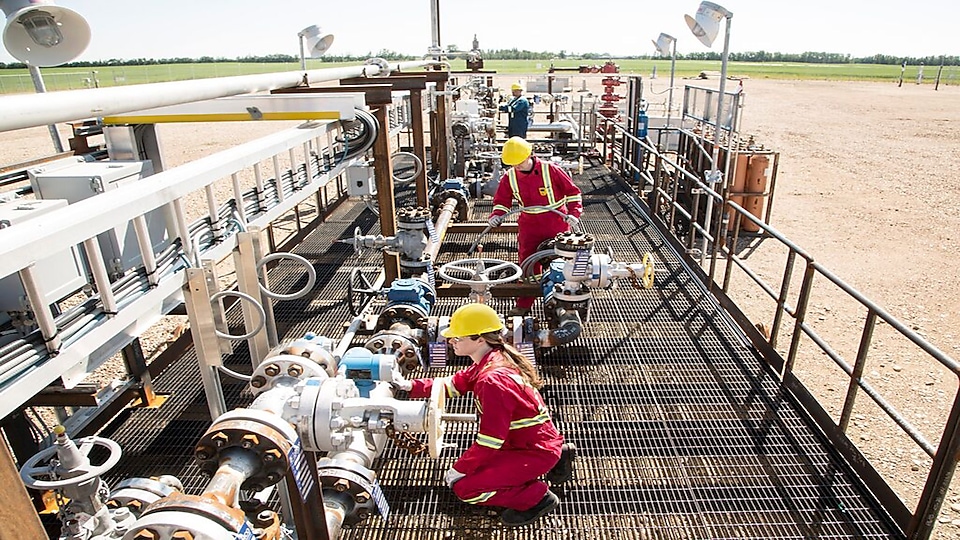
Quest Carbon Capture and Storage
Located at the Scotford upgrader near Edmonton, Alberta, the world-class Quest Carbon Capture and Storage (CCS) facility is proving that large-scale CO2 capture is a safe and effective measure to reduce CO2 emissions from industrial sources.

Achieving Net Zero by 2050
There is no single solution to the urgent challenge of cutting carbon emissions to limit global temperature rise. CCS offers a way to reduce emissions from sectors that are hard-to-decarbonise. CCS is a combination of technologies that capture and store carbon dioxide deep underground, preventing its release into the atmosphere.
At Shell, we believe that CCS will be essential for helping society to achieve net-zero emissions. Our ambition is to work with governments customers and partners to unlock the potential for CCS around the world.
Shell’s target is to become a net-zero emissions energy business by 2050, and we know that our business plans need to change to make this happen.
Avoid. Reduce. Compensate.
Our priority is to avoid emissions, for example by adopting solutions that are emissions-free when used. When this is not possible, we work to reduce emissions, for example by making use of lower-carbon fuels and technologies like CCS. If it is not possible to either avoid or reduce emissions, we will turn to the compensation of emissions, such as using carbon credits.
The Quest CCS facility is operated by Shell Canada on behalf of the Athabasca Oil Sands Project (AOSP).
The respective ownership interests of AOSP assets in aggregate, directly and indirectly, are 70% Canadian Natural Resources Limited and an affiliate, 20% Chevron Canada Limited, and 10% Shell Canada Limited through certain subsidiaries.
Shell Canada is sharing the knowledge and lessons learned from building Quest to encourage more widespread implementation of CCS. Detailed information about Quest CCS design and operations can be found on the Government of Alberta website.
Performance. CO2 Captured.
Shell Canada on behalf of the Athabasca Oil Sands Project (AOSP) has captured 7.7 million tonnes of CO2 (as at the end of 2022). For further listing details of annual CO2 captured a public database can be found here AEOR Listing Detail (csaregistries.ca)
Watch: How it works
How it works: Carbon Capture and Storage
0:00
Global demand for energy is increasing and the challenge is to meet this demand
0:04
while reducing our carbon footprint. Part of Shell’s solution involves carbon
0:08
capture and storage and that's why we built and operate Quest at the Scotford upgrader. The
0:13
upgrader turns thick heavy oil from the oil sands called bitumen into synthetic crude
0:17
that can then be refined into everyday products like gasoline and jet fuel. Shell
0:22
uses hydrogen to upgrade the bitumen to a lighter oil but making hydrogen
0:25
creates carbon dioxide or CO2 Quest captures the CO2 from the upgrader’s
0:31
hydrogen manufacturing plants with a product called Amine that absorbs CO2. The CO2
0:37
is then separated from the Amine and pressurized to turn the CO2 gas into a
0:41
liquid that can be transported by pipeline 65 kilometers north through well sites.
0:46
At the wells the liquid CO2 is injected more than two kilometres
0:50
underground into a layer of rock filled with interconnected pores. The CO2
0:55
becomes trapped within the pores and locked in under many layers of solid
0:59
watertight rock. Constant monitoring both above and below ground makes sure the CO2
1:04
stays safely and permanently in place. Quest is on track to capture and store
1:09
over one million tonnes of CO2 every year. That's equivalent to the emissions
1:13
from about two hundred and fifty thousand cars. We know that up here
1:18
carbon dioxide is a big problem but we believe deep down there lies an
1:22
important part of the solution.
YOU MIGHT ALSO LIKE
Top questions about CCS
Curious about CCS? On this page you will find answers to some of the most frequently asked questions we get about CCS.
Discover more about CCS
Carbon capture and storage offers a way to reduce emissions from sectors that are hard-to-decarbonise. Find out more about this technology and how Shell is working to unlock its potential around the world.

